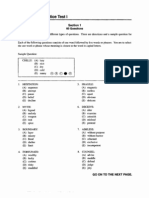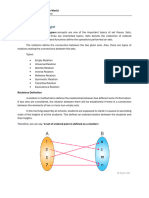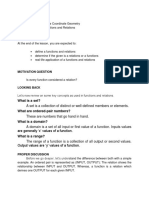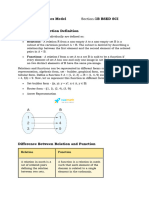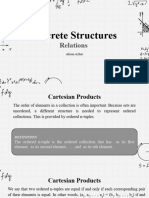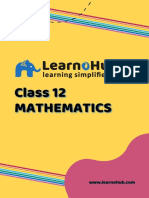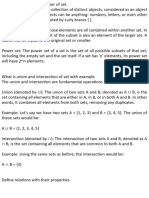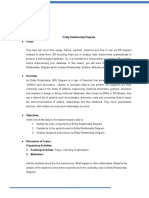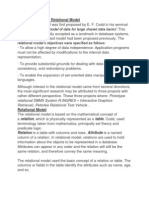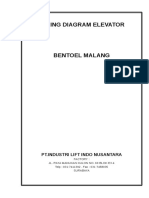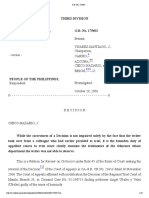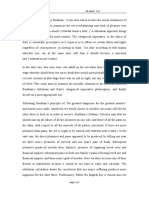0 ratings0% found this document useful (0 votes)
13 viewsModule 4 Ds2
Module 4 Ds2
Uploaded by
lumibaojohnwendleCopyright:
© All Rights Reserved
Available Formats
Download as PPTX, PDF, TXT or read online from Scribd
Module 4 Ds2
Module 4 Ds2
Uploaded by
lumibaojohnwendle0 ratings0% found this document useful (0 votes)
13 views16 pagesCopyright
© © All Rights Reserved
Available Formats
PPTX, PDF, TXT or read online from Scribd
Share this document
Did you find this document useful?
Is this content inappropriate?
Copyright:
© All Rights Reserved
Available Formats
Download as PPTX, PDF, TXT or read online from Scribd
Download as pptx, pdf, or txt
0 ratings0% found this document useful (0 votes)
13 views16 pagesModule 4 Ds2
Module 4 Ds2
Uploaded by
lumibaojohnwendleCopyright:
© All Rights Reserved
Available Formats
Download as PPTX, PDF, TXT or read online from Scribd
Download as pptx, pdf, or txt
You are on page 1of 16
Exploring Relations Between Two Sets
ALBERT C. QUINIONES, LPT
Introduction to Set Theory
● What is a set? A collection of distinct objects, considered as an object in its
own right.
● Sets can be anything: numbers, people, letters, etc.
● Example: Set A = {1, 2, 3}, Set B = {a, b, c}
● Can you think of a set that represents your favorite things?
Defining Relations
● A relation is a connection between elements of two sets.
● It pairs elements from one set (the domain) to another (the range).
● Example: In a classroom, a relation could be "is a friend of."
● What other relations can you observe in your daily life?
Types of Relations
● One-to-One: Each element of one set is related to a unique
element of the other set.
● One-to-Many: An element of one set may be related to several
elements of the other set.
● Many-to-One: Several elements of one set may be related to a
single element of the other set.
● Many-to-Many: Elements of one set are related to many
elements of the other set, and vice versa.
● Which type of relation do you think is most common in social
networks?
Visualizing Relations with
Arrow Diagrams
● Arrow diagrams show how elements from
one set are related to elements of another
set.
● Each element is represented by a point,
and arrows indicate the relations.
● Can be used to easily identify the type of
relation.
● Let's draw an arrow diagram for the
relation "is a sibling of" in your family.
Cartesian Product
● The Cartesian product of two sets A and
B, denoted A x B, is the set of all ordered
pairs (a, b) where a is in A and b is in B.
● Example: If A = {1, 2} and B = {a, b}, then
A x B = {(1, a), (1, b), (2, a), (2, b)}.
● The Cartesian product is the foundation
for defining relations mathematically.
● How would the Cartesian product change
if set A or B had more elements?
Domain and Range
● Domain: The set of all first elements in the ordered pairs of a
relation.
● Range: The set of all second elements in the ordered pairs of a
relation.
● Example: If R = {(1, a), (2, b)}, then Domain(R) = {1, 2} and
Range(R) = {a, b}.
● Can you find the domain and range of your previous arrow
diagram?
Function as a Special Relation
● A function is a relation where each element in the domain is related to exactly
one element in the range.
● Not all relations are functions, but all functions are relations.
● Example: f(x) = x^2 is a function because each x-value has a unique y-value.
● Think of a real-world example where a function might be used.
Injective, Surjective, and Bijective Functions
● Injective (One-to-One): No two different elements in the domain map to the
same element in the range.
● Surjective (Onto): Every element in the range is mapped to by at least one
element in the domain.
● Bijective: A function that is both injective and surjective.
● Can you identify an example of each type of function in real life?
Graphing Relations
● A graph can represent the relationship between two sets.
● Points on the graph correspond to ordered pairs in the relation.
● The visual representation helps to understand the nature of the
relation.
● Try graphing the function f(x) = x + 1. What does the graph tell
you about the relation?
Inverse Relations
● An inverse relation swaps the elements in each ordered pair of the original
relation.
● If R is a relation from set A to B, then R^-1 is the inverse relation from B to A.
● For functions, the inverse function, if it exists, reverses the input-output
relationship.
● What would be the inverse relation of "is a parent of"?
Composition of Relations
● Composing two relations R and S gives a new relation where the output of R
becomes the input of S.
● Denoted as S o R, read as "S composed with R."
● For functions, (f o g)(x) means apply g to x, then apply f to the result.
● Can you think of a scenario where composition of relations might be useful?
Properties of Relations
● Reflexive: Every element is related to itself.
● Symmetric: If a is related to b, then b is related to a.
● Transitive: If a is related to b and b is related to c, then a is
related to c.
● These properties help classify relations into different categories.
● Which property do you think is most important for the relation "is
equal to"?
Equivalence Relations
● An equivalence relation is reflexive, symmetric, and transitive.
● It partitions a set into equivalence classes, where each class represents a set
of related elements.
● Example: "Has the same birthday as" is an equivalence relation among
people.
● What equivalence relations can you identify in your school?
Partial and Total Orders
● Partial Order: A relation that is reflexive, antisymmetric, and transitive.
● Total Order: A partial order where every pair of elements is comparable.
● Example of Total Order: The less than or equal to relation (≤) on the set of
real numbers.
● Can you find an example of a partial order in a library or bookstore?
Applications of Set Relations
● Database management: Relations are used to link tables based
on common attributes.
● Social networks: Understanding connections between users.
● Scheduling: Relations help in matching tasks with time slots or
resources.
● Can you propose a new application for set relations in
technology?
You might also like
- SSAT Lower Level Test 1Document34 pagesSSAT Lower Level Test 1Kevin Jang83% (6)
- Relations and FunctionsDocument24 pagesRelations and FunctionssyedhaidershujaNo ratings yet
- Functions and RelationsDocument4 pagesFunctions and Relationsadrianniel.garigNo ratings yet
- Class 12 Maths Chapter Wise Topic Wise Notes Chapter 1 RelationDocument129 pagesClass 12 Maths Chapter Wise Topic Wise Notes Chapter 1 Relationkurinjikothai0501No ratings yet
- Math Project 1Document15 pagesMath Project 1premi.queen34591No ratings yet
- Handout 05 Relations and Its TypeDocument12 pagesHandout 05 Relations and Its TypeRK OrdinarioNo ratings yet
- Functions Vs Relations: Lesson 1.2Document33 pagesFunctions Vs Relations: Lesson 1.2hi mynameNo ratings yet
- CHAPTER 3 LECTURE SET and LOGICDocument7 pagesCHAPTER 3 LECTURE SET and LOGICVincent L. SantiagoNo ratings yet
- SAS Day11 - ITE048 Discrete StructureDocument8 pagesSAS Day11 - ITE048 Discrete StructureKristian Eisen Mingarine MenianoNo ratings yet
- SBOA Class 11 Maths Summer Break HWDocument13 pagesSBOA Class 11 Maths Summer Break HWSaikatNo ratings yet
- Week 4 - Mathematical Relation and FunctionDocument24 pagesWeek 4 - Mathematical Relation and FunctionAllen PusongNo ratings yet
- Module in Modern Geometry (Functions and Relations)Document10 pagesModule in Modern Geometry (Functions and Relations)Marjory GuillemerNo ratings yet
- subtitle (11)Document2 pagessubtitle (11)kieumi286No ratings yet
- DSCR Midterm ReviewerDocument5 pagesDSCR Midterm Reviewerjustme2No ratings yet
- RELATION AND FUNCTIONDocument4 pagesRELATION AND FUNCTIONnavjot67raiNo ratings yet
- 2.3 Relation and FunctionDocument6 pages2.3 Relation and FunctionJasmine JeganNo ratings yet
- Relations and FunctionsDocument17 pagesRelations and Functionsaditya100% (1)
- Discrete Mathematics - Chapter 7 Posets Lattices & Boolean AlgeDocument82 pagesDiscrete Mathematics - Chapter 7 Posets Lattices & Boolean AlgeBeautiful-Pretty Happy-WealthyNo ratings yet
- Inbound 2549714054604090686Document7 pagesInbound 2549714054604090686starnext143zNo ratings yet
- Relation and Function - PDFDocument9 pagesRelation and Function - PDFDevansh Pandey100% (1)
- Discrete Structure 2Document23 pagesDiscrete Structure 2malikabdullah0120No ratings yet
- 2023-24 MMW Module 2CLanguage of Functions and RelationsDocument12 pages2023-24 MMW Module 2CLanguage of Functions and Relations2023-201655No ratings yet
- ChristianDocument12 pagesChristianChristian Villamora Delos TraycoNo ratings yet
- Cbse Xii Volume 1 - Formulae and ConceptsDocument50 pagesCbse Xii Volume 1 - Formulae and ConceptsAdarsh ThakurNo ratings yet
- 03 RelationsDocument31 pages03 Relations221502No ratings yet
- 12th Cheat Sheet Chapter 1Document5 pages12th Cheat Sheet Chapter 1Sneha SinghNo ratings yet
- Maths PPT by Ritika Nagar on Relation & Functions (2)Document16 pagesMaths PPT by Ritika Nagar on Relation & Functions (2)royalwhitey12No ratings yet
- 2.3 Relation and FunctionDocument41 pages2.3 Relation and FunctionAlma G. FloridaNo ratings yet
- Sets and RelationsDocument11 pagesSets and RelationssudaisomutoNo ratings yet
- NotesDocument19 pagesNotesGauravNo ratings yet
- Class - 11 Maths Lesson Plan Chapter Wise Topic Wise CH 2 Relations and Functions (2024-25)Document50 pagesClass - 11 Maths Lesson Plan Chapter Wise Topic Wise CH 2 Relations and Functions (2024-25)whyviy40022004No ratings yet
- Relation Project - Docx - 20240918 - 190702 - 0000.pdf - 20240928 - 070608 - 0000Document6 pagesRelation Project - Docx - 20240918 - 190702 - 0000.pdf - 20240928 - 070608 - 0000s4sasmitamarndiNo ratings yet
- Relations and FunctionsDocument14 pagesRelations and FunctionsMeliza AdvinculaNo ratings yet
- EEE207 Database Concepts Lecture 2Document23 pagesEEE207 Database Concepts Lecture 2mainajames10532No ratings yet
- Relations in Discreet math-WPS OfficeDocument1 pageRelations in Discreet math-WPS Officelorainegamora626No ratings yet
- Relation Project - Docx - 20240918 - 190702 - 0000Document6 pagesRelation Project - Docx - 20240918 - 190702 - 0000s4sasmitamarndiNo ratings yet
- Relations and Functions Class 12 Notes CBSE Maths Chapter 1 (PDF)Document4 pagesRelations and Functions Class 12 Notes CBSE Maths Chapter 1 (PDF)ak9119648872No ratings yet
- Lecture 1 MATH 8Document50 pagesLecture 1 MATH 8Samantha CincoNo ratings yet
- Function and RelationDocument28 pagesFunction and RelationMarjory GuillemerNo ratings yet
- Relations and FunctionsDocument11 pagesRelations and FunctionsTushar GuptaNo ratings yet
- Chapter 2 - Module 1Document107 pagesChapter 2 - Module 1Narmatha ThiyagarajanNo ratings yet
- Computer FundamentalDocument17 pagesComputer Fundamentalupendrapaudel0No ratings yet
- Relations and Functions NotesDocument4 pagesRelations and Functions NotesavneetkulwinderNo ratings yet
- Expl - Relations and FunctionsDocument2 pagesExpl - Relations and FunctionsSebastian Camilo SalamancaNo ratings yet
- SAS Day11 - ITE048 Discrete StructureDocument9 pagesSAS Day11 - ITE048 Discrete StructureKristian Eisen Mingarine MenianoNo ratings yet
- Becc 102 em Gp.Document28 pagesBecc 102 em Gp.nikita rawatNo ratings yet
- The Objectives of Discrete Mathematical Structures AreDocument30 pagesThe Objectives of Discrete Mathematical Structures AreKarthikeyan RamajayamNo ratings yet
- Course Instructors: Dr. Victor T. Odumuyiwa Dr. Ufuoma C. Ogude Department of Computer Sciences University of LagosDocument26 pagesCourse Instructors: Dr. Victor T. Odumuyiwa Dr. Ufuoma C. Ogude Department of Computer Sciences University of LagosOriola KolawoleNo ratings yet
- Matheatics ProjectDocument21 pagesMatheatics Project6shikharsinghNo ratings yet
- Module3(Mapping)Document45 pagesModule3(Mapping)oceanchaudhary2004No ratings yet
- Cabrera RW1Document2 pagesCabrera RW1Nikolai CabreraNo ratings yet
- Chapter 2 Mathematics in The Modern WorldDocument12 pagesChapter 2 Mathematics in The Modern Worldnew chaisiriwongNo ratings yet
- ME-GM-11-Q1-0102-PS-2Document31 pagesME-GM-11-Q1-0102-PS-2Yhannie TunacaoNo ratings yet
- 2014 Ensenar A Investigar Una Didactica Nueva de La Investigacion en Ciencias Sociales y HumanasDocument17 pages2014 Ensenar A Investigar Una Didactica Nueva de La Investigacion en Ciencias Sociales y HumanasMica ElaNo ratings yet
- Rdbms (Unit 2)Document9 pagesRdbms (Unit 2)hari karanNo ratings yet
- Relations NOTESDocument7 pagesRelations NOTESSharonNo ratings yet
- Handouts - Entity Relationship DiagramDocument8 pagesHandouts - Entity Relationship Diagramsecret studetNo ratings yet
- Set TheoryDocument12 pagesSet TheoryAbdela Aman MtechNo ratings yet
- TOC Chapter-1-For ReferenceDocument70 pagesTOC Chapter-1-For Referenceaksharkevadiya20No ratings yet
- Brief History of The Relational ModelDocument5 pagesBrief History of The Relational ModelSaleem KhanNo ratings yet
- The Number Concept, True its Definition and The Division by ZeroFrom EverandThe Number Concept, True its Definition and The Division by ZeroNo ratings yet
- Wa0000Document90 pagesWa0000Mimi juwonNo ratings yet
- Multiple Criteria ABC AnalysisDocument9 pagesMultiple Criteria ABC AnalysisRodrigo SantosNo ratings yet
- BOOKSDocument11 pagesBOOKSlagiabao890No ratings yet
- Trading As A Business - Chap 2Document16 pagesTrading As A Business - Chap 2David100% (1)
- The Eucharistic Words of JesusDocument275 pagesThe Eucharistic Words of JesusTeteu ApolianoNo ratings yet
- Golden Days For Boys and Girls, Vol. XII, Jan. 3, 1891 by VariousDocument130 pagesGolden Days For Boys and Girls, Vol. XII, Jan. 3, 1891 by VariousGutenberg.orgNo ratings yet
- Instant download Milady s Illustrated Cosmetology Dictionary 2nd Edition Shelley Heavilin pdf all chapterDocument81 pagesInstant download Milady s Illustrated Cosmetology Dictionary 2nd Edition Shelley Heavilin pdf all chapterravanathanga100% (4)
- Principles and Practices of Transportation Planning and Engineering 1st Edition Tang Connie download pdfDocument40 pagesPrinciples and Practices of Transportation Planning and Engineering 1st Edition Tang Connie download pdfygorniaone100% (5)
- Task Based Grammar TeachingDocument4 pagesTask Based Grammar TeachingyoghurtcheeseNo ratings yet
- Iv Ses Relig Mart 24 Los Sacramentos Yessenia CarrascoDocument7 pagesIv Ses Relig Mart 24 Los Sacramentos Yessenia CarrascoAlice Galvez MuñozNo ratings yet
- Wiring Diagram Elevator: PT - Industri Lift Indo NusantaraDocument28 pagesWiring Diagram Elevator: PT - Industri Lift Indo NusantaraGogik Anto100% (1)
- Establishing The Importance of The TopicDocument2 pagesEstablishing The Importance of The Topicfauno_ScribdNo ratings yet
- Motivation Letter BAI - hro.HRDocument2 pagesMotivation Letter BAI - hro.HRronnysukeNo ratings yet
- Detention of Juveniles in Pakistan PDFDocument6 pagesDetention of Juveniles in Pakistan PDFUsama TanveerNo ratings yet
- GR No. 175692 - DigestDocument18 pagesGR No. 175692 - DigestLeopoldo, Jr. BlancoNo ratings yet
- Science - Tech Pry PDFDocument105 pagesScience - Tech Pry PDFLovemore MalakiNo ratings yet
- KARAN KHODE RESUME E4yearsDocument2 pagesKARAN KHODE RESUME E4yearswooden makersNo ratings yet
- X SF STD InvDocument1 pageX SF STD Invasadahmedkhan129611No ratings yet
- Present Perfect TextDocument2 pagesPresent Perfect Textbranka perkovicNo ratings yet
- Erika Davis - ResumeDocument2 pagesErika Davis - Resumeapi-584363928No ratings yet
- UCL Enrolment Form 0Document1 pageUCL Enrolment Form 0kimngkq96No ratings yet
- Plans List 2nd September 2013Document5 pagesPlans List 2nd September 2013SophieCorlessNo ratings yet
- Class 2Document14 pagesClass 2Megha NNo ratings yet
- The Changing Nature of Workplace CultureDocument16 pagesThe Changing Nature of Workplace Culturemakawuhu24No ratings yet
- Caterpillar Cat M70D 3648 VOLT 7FG00600 Service Repair Manual SNA1EC4-60001 PDFDocument20 pagesCaterpillar Cat M70D 3648 VOLT 7FG00600 Service Repair Manual SNA1EC4-60001 PDFjfjkkskemmdm100% (1)
- Dudley V ParkerDocument7 pagesDudley V ParkerHe JiaxinNo ratings yet
- Marketing Research On Customer Satisfaction Towards Retail Shops in MallsDocument52 pagesMarketing Research On Customer Satisfaction Towards Retail Shops in MallsPrateek AgrawalNo ratings yet
- Manjusrinamasagiti in Brills EncyclopeDocument7 pagesManjusrinamasagiti in Brills EncyclopeozergyalmoNo ratings yet
- RPP CongratulationDocument14 pagesRPP Congratulationmia septianiNo ratings yet
